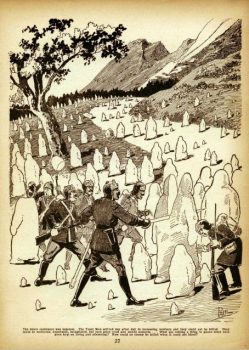Random Reviews: “The Yeast Men” by David H. Keller

Throughout 2022, I’ll be reviewing short stories. Some of these may be classics, others forgotten. The two things that all will have in common is that they are part of my personal collection and they will be selected through a randomization process. What works and authors I look at will be entirely selected by a roll of the dice.
“The Yeast Men,” which originally appeared in the April 1928 issue of Amazing Stories, was the second science fiction story published by David H. Keller, M.D., as his byline often read. He had actually been publishing as early as 1895, with the story “Aunt Martha” in Bath Weekly, under one of many pseudonyms that he used. He is believed to have been the first psychiatrist to write science fiction.
When Hugo Gernsback launched Science Wonder Stories in 1929, he listed Keller as the magazine’s Associate Science Editor. Keller also served as the editor of Gernsback’s Sexology magazine from 1934 to 1938. Keller lived from 1880 to 1966. He served in the US Medical Corps during World War II. A fan of H.P. Lovecraft, Keller was able to provide August Derleth with a sizable loan to keep Arkham House from going bankrupt during a period when there were cashflow issues.
“The Yeast Men” is set in 1930 in the fictitious European countries of Eupenia and Moronia. Premier Plautz of Eupenia is planning ahead for the next war with Moronia with the plan of utterly destroying the neighboring country, much as Cato the Elder ended every speech by calling for the destruction of Carthage, Plautz ends each speech calling for the destruction of Moronia.

When he reaches out to his military leaders, however, he learns that since the last war, Moronia has created a series of light beams around their borders. Any airplane that flies over the border without Moronian permission crashes, as Eupenia has learned at the expense of twenty planes and crews. When Colonel von Dort brings this to Plautz’s attention, Plautz responds by sacking the general, who escapes to Moronia with his family just ahead of Plautz’s plans to imprison him.
Von Dort shares the plans for Eupenia’s grand invasion of Moronia with their leadership who turn to Mr. Billing, a member of their staff of scientific investigators. Billings has been working on a project that might be able to resolve the situation: An army of men made entirely of yeast. His creation starts out small, but the yeast eventually grows over three days before dissolving into a foamy, foul-smelling goo.
Moronia launches an anticipatory invasion of Eupenia with their yeast men and the Eupenians quickly discover that the yeast men can be baked and turned into bread. However, the rate at which the Moronians can create the yeast men and send them into Eupenia outstrips the pace at which bread can be baked and the yeast men begin to turn to noxious goo, resulting in the Eupenian’s eventual surrender to the Moronians.

Keller’s story should be more humorous in nature, however he tells the story in a very matter of fact way, resulting in a serviceable tale that only hints at its potential. While the elements of humor are there, perhaps the most humorous aspect of the story is editor Hugo Gernsback’s claim that the story “contains good science, for the Yeast Men actually could perform all the things that Dr. Keller so vividly portrays here.”
In many ways “The Yeast Men” is a product of its time. Keller’s Eupenia and Moronia evoke images of post-war Germany before the Nazis were able to fully infiltrate themselves in the German body politic. Eupenia’s Premier Pautz, particularly, seemed to be modeled after the sort of World War I general who was insistent on trying to fight the previous war without an understanding of how warfare had changed (actually, Pautz seems to have completely missed World War I and seemed to think the prior century’s wars were still the model for warfare, although with the addition of airplanes).
“The Yeast Men” shows an author who has interesting ideas, although one who hasn’t honed his craft, either as a writer or trying to follow through on the ramifications of what he is writing. He would, however, have a lengthy career as an author, although one that was strongly supported by his medical practice. In addition to the science fiction he published, he also sold stories in a variety of other genres, often using a pseudonym, including Monk Smith, Matthew Smith, Amy Worth, Henry Cecil, Cecilia Henry, and Jacobus Hubelaire. The last of which shares a surname with the King of Moronia in “The Yeast Men.”

 Steven H Silver is an eighteen-time Hugo Award nominee and was the publisher of the Hugo-nominated fanzine Argentus as well as the editor and publisher of ISFiC Press for 8 years. He has also edited books for DAW, NESFA Press, and ZNB. His most recent anthology is Alternate Peace and his novel After Hastings was published in 2020. Steven has chaired the first Midwest Construction, Windycon three times, and the SFWA Nebula Conference 6 times. He was programming chair for Chicon 2000 and Vice Chair of Chicon 7.
Steven H Silver is an eighteen-time Hugo Award nominee and was the publisher of the Hugo-nominated fanzine Argentus as well as the editor and publisher of ISFiC Press for 8 years. He has also edited books for DAW, NESFA Press, and ZNB. His most recent anthology is Alternate Peace and his novel After Hastings was published in 2020. Steven has chaired the first Midwest Construction, Windycon three times, and the SFWA Nebula Conference 6 times. He was programming chair for Chicon 2000 and Vice Chair of Chicon 7.